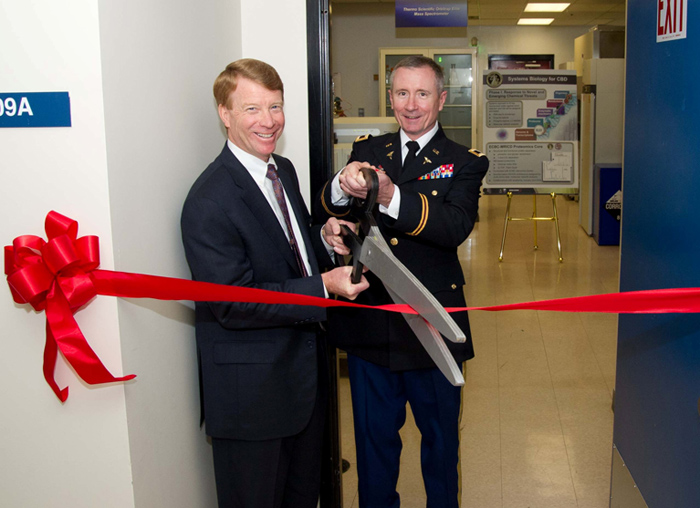USAMRICD joins forces with ECBC to develop Proteomics Core Facility

The U.S. Army Medical Research Institute of Chemical Defense at Aberdeen Proving Ground, Md., collaborated with the U.S. Army Edgewood Chemical Biological Center, also at APG, to build a joint Proteomics Core Facility, which officially opened for business on October 10. According to Dr. James F. Dillman III, chief of USAMRICD's Science Program Plans, Analysis, and Integration Office, the Proteomics Core Facility is "shows the spirit of cooperation that exits across the Edgewood campus."
"The fact that two organizations came together to build a joint capability is a wonderful testament to the true spirit of collaboration in support of common scientific research, and I hope that this serves as a great example for other installations," said Col. Bruce Schoneboom, USAMRICD commander. "I am very excited to see the great strides the talented USAMRICD and ECBC staff will take in proteomics and genomics research."
Building the capability took well over a year and was supported initially by funding from the Office of the Assistant Secretary of Defense for Nuclear, Chemical, and Biological Defense/Chemical and Biological Defense Programs, and was augmented by both ECBC and USAMRICD investments.
One purpose of the facility is to support systems biology programs of the Joint Science and Technology Office, Defense Threat Reduction Agency, which address toxicological target discovery research. The facility will also support efforts funded by the National Institutes of Health CounterAct program.
The 625-square-foot Proteomics Core Facility is located on the third floor of the McNamara Life Sciences Building, where ECBC has established a state-of-the-art Genomics Laboratory, an asset available to USAMRICD scientists. The USAMRICD already has an exceptional transcriptomics and a microarray core facility, which can be used by ECBC scientists. The newly added equipment of the Proteomics facility allows ECBC and USAMRICD to extend their research using mass spectrometry-based proteomics, high content image analysis of cells and tissues and gel-based imaging.
"Both ECBC and MRICD saw this as a need," said Dr. Jennifer Sekowski, molecular toxicologist and ECBC lead for standing up the Proteomics Core Facility. "We already had some individual proteomics and genomics tools at hand, but knew we both needed to expand our toolset."
"Rather than duplicate the capabilities, why not build our capabilities in one joint facility?," she said. Having a combined Genomics and Proteomics Core now allows us to more easily share our resources, provide new training opportunities, and expand the amount and type of research we both can do."
ECBC's technical director, Mr. Joseph Wienand agreed, saying, "In this time of fiscal awareness, it is a great example of our nation's leading scientists working together to share resources and save funding while working toward the common goal of the protection of our Soldiers and our nation."
Although the potential is there for collaboration in the future between USAMRICD and ECBC scientists, currently they will work on independent projects. USAMRICD scientists will focus their research efforts toward a thorough, foundational knowledge and understanding of the toxicology of chemical agents, toxic industrial chemicals, and toxins. Through this work, USAMRICD scientists will develop and test prophylactic and therapeutic countermeasures to protect warfighters and civilians against the acute and long-term effects of exposure to such agents.
ECBC scientists will focus their research efforts on the detection and understanding of exposures to toxins and various chemical and biological threat agents. This knowledge is translated into the development of more capable masks and uniforms for the Warfighter, as well as more effective decontamination materials.
In addition to Sekowski and Dillman, ECBC's Dr. Peter Emanuel, chief of the R&T BioSciences Division, and Dr. Mary Wade, acting chief of the BioDefense Branch, and USAMRICD's, Dr. Heidi Hoard-Fruchey, the Molecular Toxicology Team Lead, were instrumental in the development of the facility.
The USAMRICD is the nation's center of excellence for medical chemical defense research. For more information
about the U.S. Army Medical Research Institute of Chemical Defense, visit its website at
https://usamricd.amedd.army.mil/ ![]()
 and Facebook page at
http://www.facebook.com/USAMRICD
and Facebook page at
http://www.facebook.com/USAMRICD ![]()
 .
ECBC is the Army's principal research and development center for chemical and biological defense technology,
engineering and field operations. ECBC has achieved major technological advances for the Warfighter and for
national defense, with a long and distinguished history of providing the Armed Forces with quality systems
and outstanding customer service. ECBC is a U.S. Army Research, Development and Engineering Command laboratory
located at the Edgewood Area of Aberdeen Proving Ground, Md. For more information about the Edgewood Chemical
Biological Center, please visit its website at
http://www.ecbc.army.mil
.
ECBC is the Army's principal research and development center for chemical and biological defense technology,
engineering and field operations. ECBC has achieved major technological advances for the Warfighter and for
national defense, with a long and distinguished history of providing the Armed Forces with quality systems
and outstanding customer service. ECBC is a U.S. Army Research, Development and Engineering Command laboratory
located at the Edgewood Area of Aberdeen Proving Ground, Md. For more information about the Edgewood Chemical
Biological Center, please visit its website at
http://www.ecbc.army.mil ![]()
 or call (410) 436-7118.
or call (410) 436-7118.
Katherine Smith from ECBC's Research & Technology Directorate contributed to this article.














